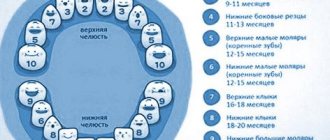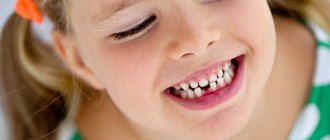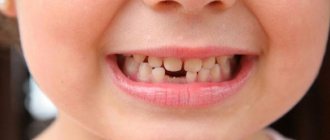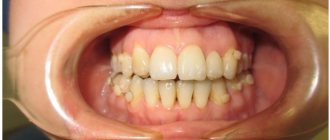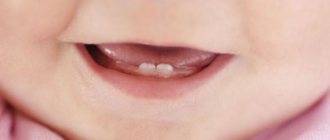During the first years of life, a baby's body undergoes many changes. Moreover, these changes are quite fast and active. The child takes his first steps, speaks his first words and his first teeth erupt. Not all changes in a growing child’s body are painless and smooth.
Is it normal for babies to have a teething fever?
When teething, your baby may actually develop a fever. When a tooth moves inside the gum, its tissue is injured. The child is in pain and is nervous. And since the baby’s thermoregulation mechanisms are not yet perfect, his temperature can rise even in response to stress. Later, when baby teeth are replaced with permanent teeth, the child may also experience discomfort, but his temperature will remain normal.
However, an increase in temperature during teething may also indicate that the child is simply sick. When a baby is teething, his body experiences additional stress, so his immunity is weakened. Sometimes parents attribute a high fever to “teeth,” but at this time it is necessary to treat the viral infection.
Why is high temperature dangerous for a child and when should you sound the alarm?
High temperature (39-40 degrees) is extremely dangerous for children in their first year of life. Because of this, disruption of the central nervous system and heart, and convulsions are possible. A rapid increase over several hours and one that is difficult to bring down with antipyretics is very dangerous.
As a result of a sharp increase, the temperature center of the brain is not able to withstand such a load, which can cause seizures. Children with central nervous system pathology are at risk. They cannot be risked, and the temperature must be brought down as soon as it has already risen to 37.5 degrees.
What to do if your child has a fever?
If, when teething, the child is restless, asks to be held, or cries, there is no need to worry. All parents go through this, you are not the first and you will not be the last. It is much worse if the baby does not react to anything, constantly sleeps and behaves very calmly. When the temperature rises, this is an alarming signal.
In this case, monitor your child with special attention and measure the temperature every hour. This can be done in the crease near the groin or armpit. To do this, it is better to use an electronic thermometer: it will be able to show you the result much faster than a mercury thermometer, in addition, it is more accurate. It is also safer and cannot be broken.
If the child’s temperature cannot be measured this way, it can be done rectally. To do this, lubricate the tip of the thermometer with baby cream, then carefully insert it into the rectum. Pinch the child's buttocks and wait for a signal indicating that the measurement is complete.
Important: when measured in the rectum, the values will always be higher compared to those in the armpit. The norm is a temperature within 37-37.5 degrees. Once you get a score of 38.5 or higher, be sure to shoot it down.
How do you know if your baby is unwell? There are signs that indicate a condition where high fever is dangerous:
- The skin feels dry and hot to the touch.
- Lips become dry.
- Eyes sparkle.
- Cheeks turn red.
- The baby rarely urinates.
If you see them, remember that urgent help is needed, because this condition is extremely dangerous for the child’s body.
Methods for reducing temperature
To reduce fever in young children, you can only use drugs based on paracetomol or ibuprofen in the form of syrups and suppositories. Tablets are not given to children under 3 years of age, as it is difficult to correctly calculate the dosage of the medicine.
When the temperature is high, the child needs to be given water often. Warm water, fruit drinks and compotes without sugar, and children's tea with rose hips are suitable. If the child is breastfeeding, continue breastfeeding as required and supplement between feedings.
The room of a sick child must be regularly ventilated and the air humidity in it must be at least 40%. To do this, you can use humidifiers or at least hang wet towels. The room temperature should not be higher than 18-20 ℃.
Thus:
- Temperature during teething in babies of the first year of life, one year and older is normal if other reasons for its increase are excluded.
- During teething, the temperature lasts an average of 1-3 days.
- Temperatures above 38.5 ℃ should be alarming, since during teething it increases by only half a degree.
- Temperatures above 38.5 ℃ should be brought down. If the child is capricious and does not feel well, then an antipyretic can be given at a lower temperature.
- The temperature of young children is brought down with paracetamol and ibuprofen in the form of syrups and suppositories. The room where the child is located must be regularly ventilated, wet cleaned, and ensure normal humidity and temperature. A sick child should be provided with rest and plenty of warm drinks.
(0 ratings; article rating 0)
Share Share Share
Temperature on teeth.
How long can it last? That's the whole question...
My son woke up on Tuesday morning, somewhat calm, sat him down for breakfast - he didn’t eat, I touched him - he seemed hot, they took his temperature - 38, lay there for an hour - and measured all 39. I called the doctor. The pediatrician came, no cough, no snot, fever and that’s it. I saw 4 chewing teeth at once and said they were all cutting together at once and would come out by Friday. And the neck is a little red. She prescribed us Augmentin (an antibiotic) - to prevent laryngitis against the background of teeth, along with Linex for possible diarrhea from taking an antibiotic, Protorgol to prevent a runny nose from starting, Fenistil for a possible allergy to medications, spray Miramistin on the gums (why?), and Viburkol suppositories and smear Baby Doctor on your gums - this is directly from the teeth. I asked - what if the temperature persists? She says that everything will go away with an antibiotic.
But in the end we decided not to give the antibiotic; Linex is not needed in this case. I still don’t have a runny nose, thank God, I don’t need Fenistil either, I don’t understand why Miramistin, and my son won’t even let us look at his mouth in any case, let alone do anything there. In the end, I was left with Viburkol suppositories, but somehow without any effect (and I don’t really believe in homeopathy, to be honest, it never helps me). The temperature yesterday and the day before yesterday did not drop below 37.8 even with Tsefekon suppositories and Nurofen mixture, the mother-in-law raises a panic that these are not teeth, we still have no other symptoms of anything (well, maybe only the voice sometimes gets a little hoarse if the child screams for something -demanding). Yesterday, rushing around the apartment with my husband in a panic at night (temperature 39), I put in Cefekon and gave Nurofen almost immediately - the temperature subsided (but I was scolded by a pediatrician friend). The result is that a child with a normal temperature woke up shortly after a night’s sleep (though he fell asleep only at 3 am with a fight, but that’s another epic). Now he’s sitting watching cartoons, his temperature is normal for now.
It’s just that if now the temperature suddenly rises again, I’m probably too late to call the pediatrician today. and what should I tell her? I called you, but did not treat the child as you said. Why did you call then? It’s just a shame... But even for prophylaxis, giving an antibiotic is somehow too much. In general, I’m sitting here reproaching myself, what kind of mother is she... A sick child, and what the hell am I doing...
Dear girls, scold me, calm me down, tell me how you cut your teeth? What was the temperature, for how long, what did the doctors prescribe, how did you cope? So the child is cheerful, even with a fever, plays and runs around the apartment. Just more moody, and sometimes looks sick when he’s tired. He has a great appetite, drinks a lot, and pees a lot too)
Teething symptoms
A child's first teeth begin to erupt between 4 and 8 months. There are exceptions. Sometimes children are born with several teeth, while others show them only after a year. Teething is a difficult process for a child. It can be accompanied by various symptoms, but the most common are the following:
- How long does it take for drugs to leave the body?
- Increased nervousness. The child cries for no reason, whines. Teething may be accompanied by painful sensations that prevent him from sleeping normally. As a result, the regime of wakefulness and rest is disrupted.
- Heavy salivation. This is a protective process. Saliva has anti-inflammatory and bactericidal properties. Hypersalivation helps protect inflamed gums from infection. Sometimes there is so much saliva that it flows down the chin onto the neck and chest. You should not constantly rub your baby's delicate skin. It is permissible to periodically carefully blot with dry wipes.
- Loose stools. During teething, the baby may experience diarrhea. It is caused by increased salivation, changes in intestinal microflora, or increased bacterial activity due to a decrease in the body's immune defense.
- Decreased appetite. Often, due to pain in the gums, infants refuse to eat. In this case, it is a little easier for those who are breastfed, since the sucking process calms and pacifies the baby.
- Inflammation of the gums. This is the natural state of affairs at the time of teething. If a white stripe appears in some place of the gum, the tooth will soon come out.
- Runny nose. Sometimes swelling and inflammation from the gums spreads to the nasal mucosa. As a result, the baby begins to snot.
- Itching in the gums. The baby puts all the objects that come to hand into his mouth. This is how he scratches his gums. To make his task easier, you can purchase special teething toys in stores.
- Hyperthermia. The temperature rises in 80% of cases. It is important to ensure that it does not reach critical levels. Once every 1-2 hours, it is recommended to measure it not with an electronic, but with a mercury thermometer, since it is more reliable.
All these symptoms frighten parents, as they are similar to the signs of many other diseases of the upper respiratory tract and gastrointestinal tract. These symptoms are typical for teething. But you need to monitor the baby’s condition very carefully, and if the clinic is accompanied by other alarming symptoms, you need to immediately contact your doctor.
Warning symptoms
During the period of teething, the child’s body is weakened and therefore more susceptible to viral or bacterial diseases. At this time, you need to monitor your baby with maximum attention. You should seek help from a doctor if you have the following symptoms:
- The baby's nose is very stuffy and a purulent substance is released from it. Such signs indicate the likelihood of rhinitis, which can only be cured with medication.
- The appearance of diarrhea does not mean that it is directly related to teething. Most likely, an infection entered the child's stomach through toys or a gum teether. The baby should be shown to a doctor.
- During teething, the baby's mouth produces copious amounts of saliva. The child does not always have time to swallow it, and this causes him to cough, or rather, cough. If the cough becomes prolonged, this means that the baby’s respiratory system has become infected. You can’t do this without the help of a doctor.
- It should also be taken into account that teething cannot cause redness in the throat. If this happens, it means that the child has pharyngitis or a general respiratory disease.
- Vomiting at elevated body temperature during teething is an alarming signal. This happens when the nervous system is damaged or due to an intestinal infection. Calling a doctor in such a situation is mandatory.
All of the above symptoms are alarming, even if they appear without elevated body temperature.
When and in what order do baby teeth emerge?
For most children, the teething pattern looks like this:
- At 6-8 months, two central lower incisors appear.
- At 8-9 months, the upper central incisors.
- At 9-12 months, the upper lateral incisors erupt.
- At 11-12 months, the lower lateral incisors.
- At 12-15 months, the upper and lower molars.
- At 16-18 months, the upper canines
- At 18-20 months, the lower canines.
- Chewing teeth erupt at 2-3 years of age.
During normal development, baby teeth erupt in each area within 2-10 days, and the most unpleasant symptoms usually appear within 2-5 days. All 20 baby teeth erupt by age 3.
What to do if teeth are cut chaotically and behind schedule?
There is no need to sound the alarm right away. In some children, teething begins at 3 months, and in some at 10, and this is not a pathology, but a feature of the body. The same applies to the violation of the order of appearance of the incisors.
But if there is a delay of 3-5 months, you need to go for a consultation with a pediatrician or dentist.
Why does the temperature rise
Teething is a traumatic process. Dental units damage the gum mucosa and inflammation occurs, which in medicine is called aseptic (microbial-free). This process is accompanied by an increase in temperature. In addition, during teething, some processes occur in the baby’s body that stimulate hyperthermia:
- at the site of localization of future milk teeth, specific substances necessary for softening the bone tissue of the jaw begin to be actively produced;
- Since all the forces of the child’s body are aimed at teething as quickly as possible, the immune system weakens a little. During this period, infectious agents present in the body may become active and diseases will begin to progress. Many of them are accompanied by an increase in temperature.
Damaged gums are the “entry gate” for infection. Through them, pathogenic microflora can penetrate the body and provoke the development of a septic inflammatory process. The body also responds to such an attack with an increase in temperature. To prevent infection, it is recommended to take more careful care of your baby’s gums during this difficult period for him. Pharmaceutical companies now produce many drugs that have a triple effect - relieve pain, reduce inflammation, fight viruses, bacteria and fungi. But before using these medications, it is recommended to consult your pediatrician.
Ways to lower temperature at home
- Rubdowns can be done at intervals of 2 hours. Wipe your hands, knees, armpits, and groin area with a soft cloth soaked in water at room temperature. It is important to prevent hypothermia!
- Drinking plenty of fluids is recommended to reduce fever. This will relieve intoxication and protect the child from dehydration.
The main thing that parents of a teething child will need most is patience.
If your child has dental problems, the Dentistry Center will come to the rescue. Experienced pediatric dentists work here who will find an approach to any fidget, and in a playful way will treat children’s teeth using the most modern techniques.
Doctors at our clinic work with visitors of all ages.
How long can an elevated body temperature remain?
There is no clear answer to this question. It all depends on the health of the baby. As for the results of long-term observations, on average, the increased body temperature of a child during the formation of baby teeth persists for one to three days. It is important to note that when the top of the tooth appears above the surface of the gum, body temperature returns to normal. This happens as each tooth erupts.
However, statistics show that in some children, elevated body temperature persists for four or even five days, and the fever can last only a few hours and go away on its own.
Knowing all of the above does not mean that parents should not show their baby to pediatricians. An extra examination by a specialist will never hurt, but, on the contrary, will help identify diseases at the earliest stage of their development.

